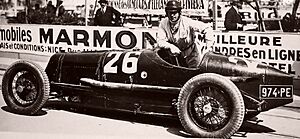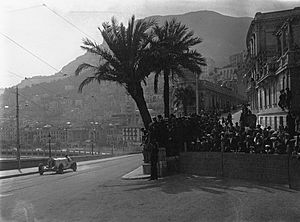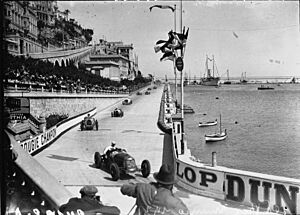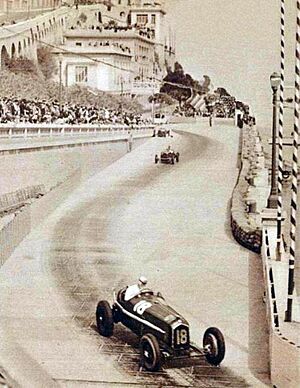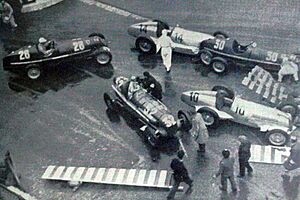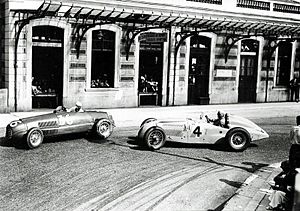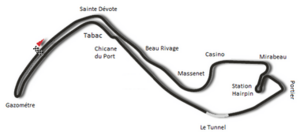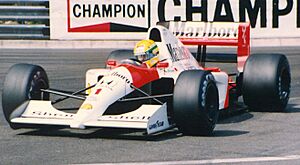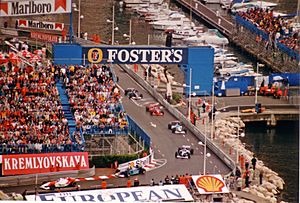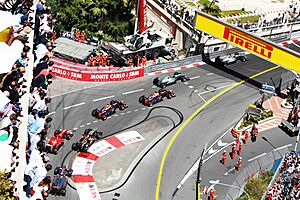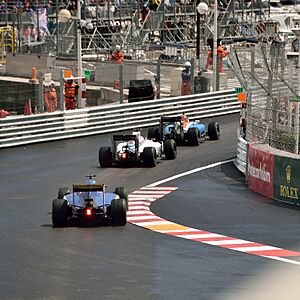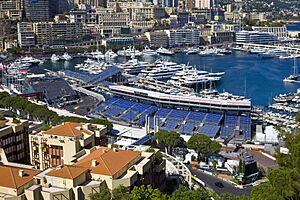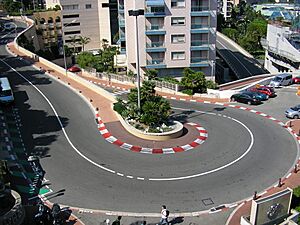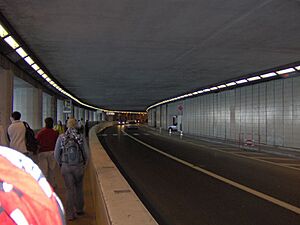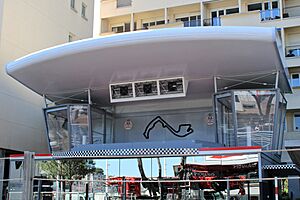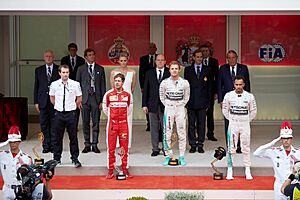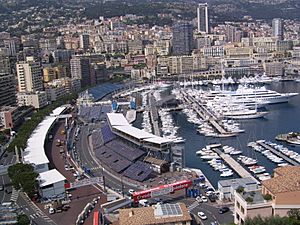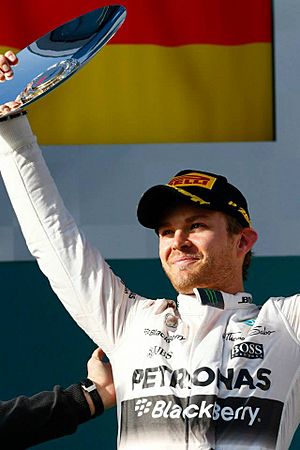Monaco Grand Prix facts for kids
| Circuit de Monaco (2015–present) |
|
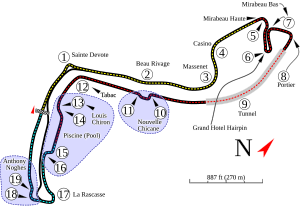 |
|
| Race information | |
|---|---|
| Number of times held | 82 |
| First held | 1929 |
| Most wins (drivers) | |
| Most wins (constructors) | |
| Circuit length | 3.337 km (2.074 mi) |
| Race length | 260.286 km (161.734 mi) |
| Laps | 78 |
| Last race (2025) | |
| Pole position | |
|
|
| Podium | |
|
|
| Fastest lap | |
|
|
The Monaco Grand Prix (in French: Grand Prix de Monaco) is a famous Formula One car race. It happens every year on the Circuit de Monaco in late May or early June. This race has been held since 1929. Many people think it is one of the most important car races in the world.
It is also one of the three races that make up the Triple Crown of Motorsport. The other two are the Indianapolis 500 and the 24 Hours of Le Mans. The Monaco Grand Prix is special because it is the only Formula One race that does not have to be at least 305 kilometers (about 190 miles) long.
The race takes place on a narrow track built right on the streets of Monaco. It has many ups and downs, tight turns, and even a tunnel. This makes it one of the hardest tracks for drivers in Formula One. Even though cars don't go super fast here, the track is dangerous because it is so narrow. Races often need a safety car to slow things down if there's an accident.
The first Monaco Grand Prix was on April 14, 1929. It later became part of the European Championship before World War II. It was also part of the first Formula One World Championship in 1950. Graham Hill was known as "Mr. Monaco" because he won the race five times in the 1960s. Ayrton Senna won the race more than any other driver, with six victories. He won five times in a row between 1989 and 1993. Only two drivers from Monaco have won the race: Louis Chiron in 1931 and Charles Leclerc in 2024.
The Monaco Grand Prix is known for its "glamour and prestige." Before 2026, the race usually happened on the last weekend of May. It was one of the biggest weekends in motor racing. This is because the Formula One race happened on the same Sunday as the Indianapolis 500 and the Coca-Cola 600 (a NASCAR Cup Series race).
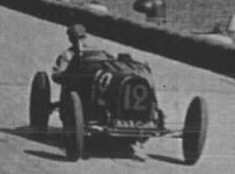
Contents
History of the Monaco Grand Prix
How the Race Started
The Monaco Grand Prix started before the modern World Championship. The first race in Monaco was organized in 1929 by Antony Noghès. He did this with the help of Prince Louis II and the Automobile Club de Monaco (ACM). The ACM wanted to become a full national club for motorsport. But the international group, AIACR, said no. They said Monaco needed a major race held completely within its borders. Their famous Monte Carlo Rally didn't count because it used roads in other countries.
So, Antony Noghès suggested creating a Grand Prix race on the streets of Monte Carlo. Prince Louis II approved the idea. Monégasque driver Louis Chiron also supported it. He believed Monaco's hills and turns were perfect for a race track.
The first race was on April 14, 1929. It was won by William Grover-Williams in a Bugatti. Not all invited drivers came, but Bugatti cars were well represented. Mercedes sent their top driver, Rudolf Caracciola. He started 15th and finished second. Louis Chiron could not race that year.
In 1931, Chiron won the race in a Bugatti. He was the only driver from Monaco to win until 2024.
Pre-War Races
The Monaco Grand Prix quickly became very important. In 1933, it was named one of the top "International Grands Prix." That year, the race was the first to decide starting positions by practice times. Before this, drivers drew lots to see where they would start. The 1933 race was exciting, with Achille Varzi winning after Tazio Nuvolari's car caught fire on the last lap.
In 1936, the race became part of the new European Championship. The 1936 race had stormy weather and many crashes. Rudolf Caracciola, known as the "Rainmaster," won. The 1937 race was the last before World War II. The race was not held in 1938 because it wasn't making enough money. Then, the war stopped all organized racing in Europe until 1945.
After the War
Car racing in Europe started again in September 1945. But the Monaco Grand Prix did not happen between 1945 and 1947 due to money problems. In 1946, a new top racing class called "Grand Prix" was created. A Monaco Grand Prix was held in 1948. It was won by Nino Farina in a Maserati 4CLT. The 1948 event also included a motorbike race.
Formula One Era Begins
Early Championship Days
The 1949 race was canceled because Prince Louis II passed away. The race joined the new Formula One World Championship in 1950. That race was the first win for future five-time world champion Juan Manuel Fangio. Louis Chiron, at 51, also finished third, his best result in the World Championship. There was no race in 1951 due to money issues and unclear rules.
In 1952, the World Championship used less powerful Formula Two cars. But the Monaco race was for sports cars and was not part of the World Championship. No races were held in 1953 or 1954 because the car rules were not ready.
The Monaco Grand Prix returned in 1955 as part of the Formula One World Championship. This started a long run of 64 years where the race was held every year. In 1955, Maurice Trintignant won. Louis Chiron, at 56, became the oldest driver to race in a Formula One Grand Prix. Stirling Moss and Trintignant both won the race twice in the late 1950s. In 1961, Moss won his third Monaco race. He held off three powerful Ferrari cars in his older Lotus car.
Graham Hill: King of Monaco
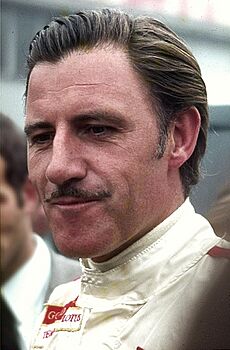
Britain's Graham Hill won the Monaco Grand Prix five times in the 1960s. He became known as "King of Monaco" and "Mr. Monaco." He first won in 1963 and then won the next two years. In the 1965 race, he started first and led. But he had to go into an escape road to avoid a slow car. He rejoined in fifth place but drove amazingly fast to win. Hill's teammate, Jackie Stewart, won in 1966. Denny Hulme won in 1967. But Hill won again in 1968 and 1969. The 1969 win was his last Formula One victory.
Track Changes and Safety
By the early 1970s, Jackie Stewart pushed for better safety in Formula One. For the 1969 race, safety barriers were put up for the first time. Before that, if a driver went off the track, they could hit buildings, trees, or even fall into the harbor. By 1972, the track was almost completely lined with safety barriers.
The Monaco circuit was changed in 1972. The pit area (where cars stop for tires and fuel) was moved. The chicane (a sharp turn) was also moved. More changes happened for the 1973 race. A new swimming pool area was built, and the track added a double chicane around it. This created space for a new pit area. In 1976, the Sainte Devote corner was made slower, and another chicane was added before the pit straight.
Prost and Senna's Dominance
From 1984 to 1993, only two drivers won the Monaco Grand Prix: Alain Prost and Ayrton Senna. Many believe they were the best drivers of that time. Prost won his first Monaco race in 1984. The race started late because of heavy rain. Prost led, but Nigel Mansell passed him. Mansell then crashed, putting Prost back in the lead. The race was stopped early because of the bad weather. Drivers only got half points since the race didn't finish two-thirds of its planned distance.
Prost won again in 1985 and 1986. In 1986, the Nouvelle Chicane was changed to make it safer.
Senna holds the record for the most wins in Monaco, with six victories. He won five times in a row from 1989 to 1993. His 1987 win was special because it was the first time a car with active suspension won a Grand Prix. Senna's wins were very popular in Monaco.
In 1988, Senna was leading by a lot. But he crashed into the barrier at the Portier corner. He was so upset that he went straight back to his apartment and didn't talk to anyone until later that evening. Prost went on to win his fourth Monaco Grand Prix.
Senna won easily in 1989, 1990, and 1991. In 1992, Nigel Mansell was leading the race. But with seven laps left, he had a loose wheel nut and had to pit. Senna took the lead on old tires. Mansell, on fresh tires, drove incredibly fast to catch up. They battled for the last four laps, but Mansell couldn't pass Senna. Senna won his fifth Monaco race, matching Graham Hill's record.
In 1993, Senna had a tough start to the weekend. But Michael Schumacher retired with car problems, and Prost had a penalty. So, Senna took his sixth win, breaking Graham Hill's record.
1990s: Sad Moments and Big Wins
The 1994 race was very emotional. It happened two weeks after the 1994 San Marino Grand Prix where two drivers, Roland Ratzenberger and Ayrton Senna, died. During the Monaco event, Karl Wendlinger had a crash in the tunnel and was seriously injured. Michael Schumacher won the 1994 race and also the 1995 event.
The 1996 race was full of surprises. Michael Schumacher started first but crashed on the first lap. Damon Hill led for a long time, but his engine broke. Jean Alesi then took the lead but also had car problems. Finally, Olivier Panis, who started 14th, moved into the lead and won the race. It was his only win in Formula One. Only three cars finished the race, but seven were still counted in the results.
21st Century Races
In 2004, new land was created, allowing the pit area to be expanded. A temporary grandstand with 6,000 seats was also built.
Seven-time world champion Michael Schumacher eventually won the race five times, matching Graham Hill's record. In the 2006 race, Schumacher caused controversy. He stopped his car on the track during qualifying, blocking other drivers. He said it was a car problem, but the FIA (the sport's governing body) disagreed. He was sent to the back of the starting grid.
In July 2010, a 10-year deal was made to keep the race in Monaco until at least 2020.
In 2025, Lando Norris set the fastest qualifying lap ever at Monaco. His time was 1:09.954.
Recent Races (2020s)
The 2020 Monaco Grand Prix was postponed due to the COVID-19 pandemic. Later, it was completely canceled. This was the first time the race was not held since 1954. The race returned in 2021.
The 2022 event saw Monégasque driver Charles Leclerc get his first pole position at Monaco. But a mistake in strategy meant he finished fourth. Sergio Pérez won that race.
In 2024, Charles Leclerc became the second Monégasque driver to win the race. The race was unusual because the top 10 cars finished in the exact same order they started. There were no successful overtakes during the race.
In November 2024, a new contract was signed. The Monaco Grand Prix will stay on the F1 calendar until 2031. As part of this deal, the race will be held on the first weekend of June starting in 2026. This means it will no longer happen on the same weekend as the Indianapolis 500.
For the 2025 Monaco Grand Prix, new tire rules were put in place. Drivers must make two mandatory tire changes during the race, using at least two different types of tires. This is different from other races where only one change to a different tire type is required. These changes apply even if wet weather tires are used. However, these new rules did not lead to more overtaking. Lando Norris won the 2025 race after starting from pole position.
The Monaco Race Track
The Grand Prix takes place on the Circuit de Monaco. This track goes through the narrow city streets of Monte Carlo and La Condamine, right next to Monaco's harbor. Monaco has hosted the Grand Prix every time it has been run since 1929. Only the Italian Grand Prix has such a long history with one track.
The circuit has many changes in height, tight corners, and is very narrow. This means drivers need to be incredibly precise. They often touch the track walls to get the fastest lap time. In 1929, a magazine said the track should be covered with "Danger" signs everywhere. As of 2022, two drivers have crashed and ended up in the harbor. The most famous was Alberto Ascari in 1955.
Even though the track has had small changes over the years, it is mostly the same as it was in 1929. It is still seen as the ultimate test of a driver's skill and mental strength. If Monaco were a new track today, it probably wouldn't be allowed to host Formula One. This is because it's short and has safety concerns, especially for overtaking. But because it's a "Crown Jewel" of Formula One with nearly a century of history, Monaco gets special exceptions.
Triple Formula One champion Nelson Piquet famously said racing at Monaco was "like riding a bicycle around your living room." This shows how challenging the narrow streets are. He also said that "a win here was worth two anywhere else."
The track includes a tunnel. Drivers have to adjust their eyes quickly when entering and leaving the tunnel. They go from bright daylight to gloom and then back to daylight. This is a challenge not found at other tracks.
The fastest-ever qualifying lap was set by Lando Norris in 2025. His time was 1:09.954.
Where to Watch the Race
During the Grand Prix weekend, many spectators gather around the Monaco Circuit. Temporary grandstands are built, mostly around the harbor. Wealthy and famous people often arrive on their yachts in the harbor. Balconies in Monaco also become viewing spots for the race. Many hotels and residents make money by offering great views of the race.
Criticism of the Track
Formula One cars have become bigger over time. But the Monaco circuit has not expanded much. This limits opportunities for overtaking and makes the race less exciting to watch. The track only has one DRS zone, which helps with overtaking. People have suggested ideas to make the track longer, safer, and better for passing. One idea was to extend the track along the east side of the harbor and add a second DRS zone. Lewis Hamilton suggested adding "more variability" to the race, like more pit stops or special tire types.
The 2024 Monaco Grand Prix was considered very boring. Formula One usually requires cars to make one pit stop and use two different tire types. But a red flag on the first lap allowed drivers to change tires early. This meant they didn't need to stop again. Because it's so hard to overtake, drivers at the front drove very slowly to save their tires. The top ten drivers finished in the exact same order they started. Max Verstappen joked about needing a pillow during the race. Because of this, new rules were made for the 2025 season. Drivers must now make at least two pit stops at Monaco to make the race more exciting.
How the Race is Organized
The Monaco Grand Prix is organized each year by the Automobile Club de Monaco (ACM). This club also runs the Monte Carlo Rally.
The Monaco Grand Prix is different from other Grand Prix races in a few ways. Practice sessions used to be on Thursday instead of Friday. This allowed the streets to be open to the public on Friday. But since 2022, the first two practice sessions are held on Friday, like other Formula One races. Support races are still on Thursday.
For many years, fewer cars were allowed to start the Monaco Grand Prix. This was because of its narrow and winding track. For example, only 18 cars were allowed to start the 1975 Monaco Grand Prix. Other races that year allowed 23 to 26 cars.
Building the circuit takes six weeks, and taking it down takes three weeks. Until 2017, there was no proper podium for the winners. Instead, the top three drivers would leave their cars in a special area. Then, they would walk directly to the royal box for the awards ceremony. The trophies were given out before the national anthems were played. This is different from other Grand Prix races where the anthems are played first.
Fame of the Monaco Grand Prix
The Monaco Grand Prix is considered one of the most important and famous car races in the world. It is part of the Triple Crown of Motorsport, along with the Indianapolis 500 and the 24 Hours of Le Mans. As of 2025, Graham Hill is the only driver to have won all three of these famous races. It's hard for a driver to compete in both the Monaco Grand Prix and the Indianapolis 500. This is because their practice sessions often overlap, and the races are on different continents. Juan Pablo Montoya and Fernando Alonso are the only active drivers who have won two of the three Triple Crown events.
The FIA (the international motorsport body) has praised the Monaco Grand Prix. They said it brings "glamour and prestige" to motorsport. Monaco's royal family has always been very interested in the race. A lot of Monaco's money comes from tourists and its famous casino. It is also a place where many rich people live, including several Formula One drivers.
Monaco has produced four Formula One drivers: Louis Chiron, André Testut, Olivier Beretta, and Charles Leclerc. Many other drivers have lived in Monaco because of its tax benefits. These include Gilles Villeneuve and Ayrton Senna. Several drivers in the 2006 Formula One season owned property there. Because Monaco is small and the track is in the city, drivers whose races end early can often walk back to their apartments in minutes. Ayrton Senna famously went back to his apartment after crashing out of the lead in the 1988 race. In the 2006 race, Kimi Räikkönen retired from the race and went to his yacht in the harbor.
The Grand Prix attracts many famous celebrities each year. They come to experience the glamour and excitement. Big parties are held in nightclubs during the Grand Prix weekend. The Port Hercule harbor fills up with people celebrating.
Criticism of the Race's Excitement
In recent years, some people have called the Monaco Grand Prix boring. Both drivers and spectators have said it's not very exciting to drive or watch. Critics point out how few overtakes happen. Also, the driver who starts in pole position (first place) often wins the race. Fernando Alonso has called it "the most boring race ever." Lewis Hamilton said the 2022 Grand Prix "wasn't really racing."
Winners
Drivers with Multiple Wins
Drivers in bold are racing in Formula One this season.
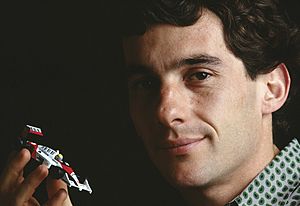
| Wins | Driver | Years won |
|---|---|---|
| 6 | 1987, 1989, 1990, 1991, 1992, 1993 | |
| 5 | 1963, 1964, 1965, 1968, 1969 | |
| 1994, 1995, 1997, 1999, 2001 | ||
| 4 | 1984, 1985, 1986, 1988 | |
| 3 | 1956, 1960, 1961 | |
| 1966, 1971, 1973 | ||
| 2013, 2014, 2015 | ||
| 2008, 2016, 2019 | ||
| 2 | 1950, 1957 | |
| 1955, 1958 | ||
| 1975, 1976 | ||
| 1977, 1979 | ||
| 2000, 2002 | ||
| 2006, 2007 | ||
| 2010, 2012 | ||
| 2011, 2017 | ||
| 2021, 2023 | ||
| Sources: | ||
Teams with Multiple Wins
Teams in bold are racing in Formula One this season.
A pink background means the event was not part of the Formula One World Championship.
A yellow background means the event was part of the pre-war European Championship.
| Wins | Constructor | Years won |
|---|---|---|
| 16 | 1984, 1985, 1986, 1988, 1989, 1990, 1991, 1992, 1993, 1998, 2000, 2002, 2005, 2007, 2008, 2025 | |
| 11 | 1952, 1955, 1975, 1976, 1979, 1981, 1997, 1999, 2001, 2017, 2024 | |
| 8 | 1935, 1936, 1937, 2013, 2014, 2015, 2016, 2019 | |
| 7 | 1960, 1961, 1968, 1969, 1970, 1974, 1987 | |
| 2010, 2011, 2012, 2018, 2021, 2022, 2023 | ||
| 5 | 1963, 1964, 1965, 1966, 1972 | |
| 4 | 1929, 1930, 1931, 1933 | |
| 3 | 1932, 1934, 1950 | |
| 1948, 1956, 1957 | ||
| 1958, 1959, 1962 | ||
| 1971, 1973, 1978 | ||
| 1980, 1983, 2003 | ||
| 2 | 1967, 1982 | |
| 1994, 1995 | ||
| 2004, 2006 | ||
| Sources: | ||
Engine Manufacturers with Multiple Wins
Manufacturers in bold are racing in Formula One this season.
A pink background means the event was not part of the Formula One World Championship.
A yellow background means the event was part of the pre-war European Championship.
| Wins | Manufacturer | Years won |
|---|---|---|
| 16 | 1935, 1936, 1937, 1998, 2000, 2002, 2005, 2007, 2008, 2009, 2013, 2014, 2015, 2016, 2019, 2025 | |
| 13 | 1968, 1969, 1970, 1971, 1973, 1974, 1977, 1978, 1980, 1982, 1983, 1993, 1994 | |
| 11 | 1952, 1955, 1975, 1976, 1979, 1981, 1997, 1999, 2001, 2017, 2024 | |
| 7 | 1987, 1988, 1989, 1990, 1991, 1992, 2021 | |
| 6 | 1995, 2004, 2006, 2010, 2011, 2012 | |
| 5 | 1958, 1959, 1960, 1961, 1962 | |
| 1963, 1964, 1965, 1966, 1972 | ||
| 4 | 1929, 1930, 1931, 1933 | |
| 3 | 1932, 1934, 1950 | |
| 1948, 1956, 1957 | ||
| 1984, 1985, 1986 | ||
| Sources: | ||
* Between 1998 and 2005 built by Ilmor, funded by Mercedes
** Built by Cosworth, funded by Ford
*** Built by Porsche
Winners by Year
A pink background means the event was not part of the Formula One World Championship.
A yellow background means the event was part of the pre-war European Championship.
Images for kids
See also
 In Spanish: Gran Premio de Mónaco para niños
In Spanish: Gran Premio de Mónaco para niños
- Triple Crown


